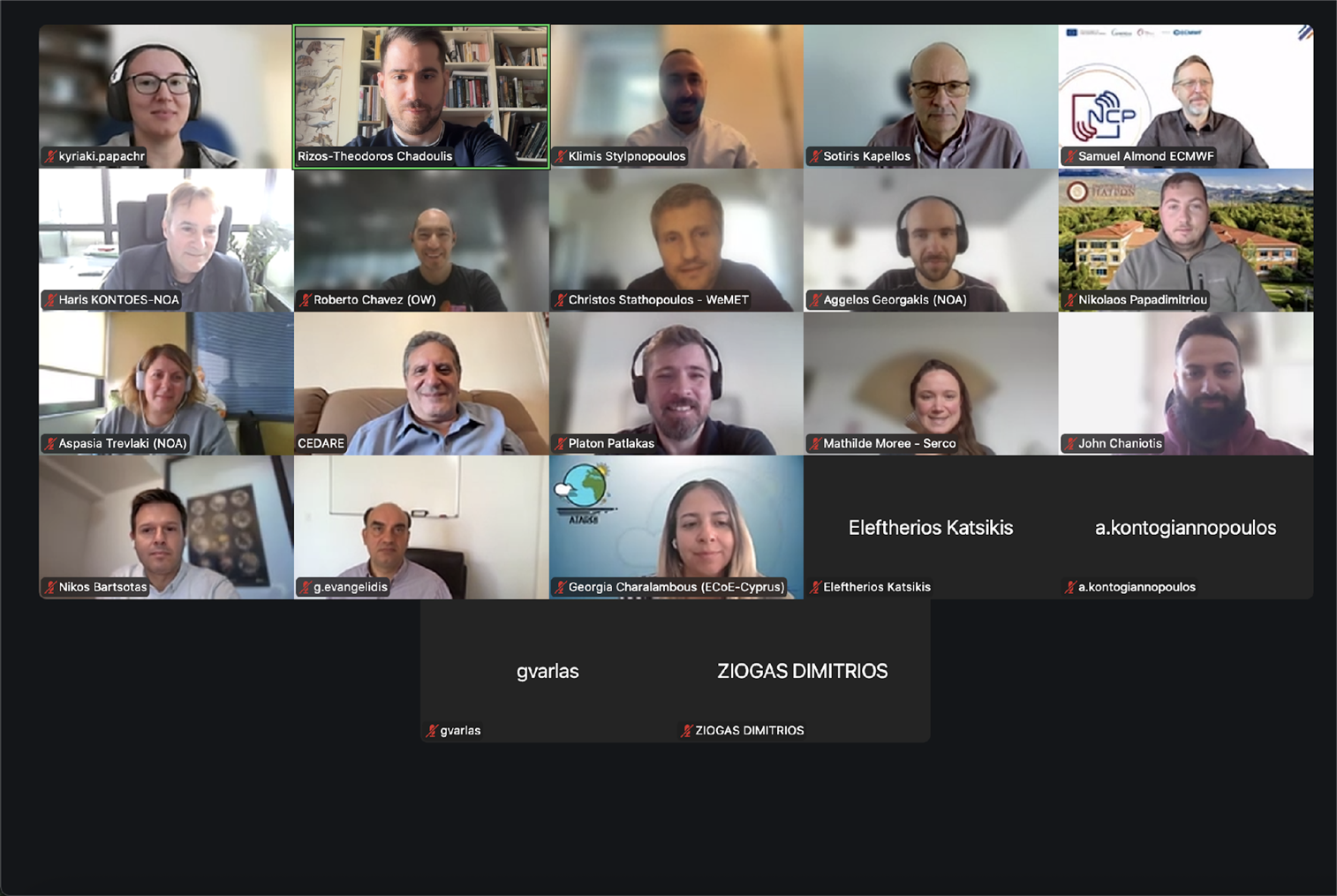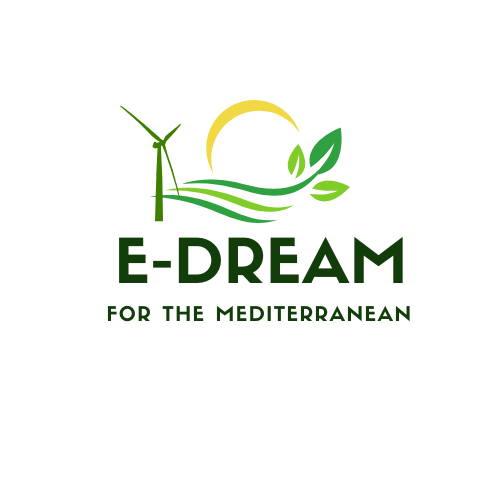Συγκεντρώνοντας εκπροσώπους ερευνητικών φορέων, επιχειρήσεων που δραστηριοποιούνται στην ενέργεια, οργανισμών κοινής ωφέλειας, δημόσιων αρχών και φορέων χάραξης πολιτικής σε μια ενδιαφέρουσα διαδικτυακή συνάντηση για την ενέργεια στην περιοχή της Μεσογείου, πραγματοποιήθηκε στις 9 Οκτωβρίου 2025 το E-DREAM User Requirements Workshop.

Το εργαστήριο διοργανώθηκε στο πλαίσιο του έργου E-DREAM (Energy Droughts and Resource Energy Assessment in the Mediterranean) που χρηματοδοτείται από το ECMWF (European Centre for Medium-Range Weather Forecasts), και υλοποιείται από κοινού από το BEYOND Centre/NOA σε ρόλο συντονιστή, και τους εταίρους WeMET, SERCO, IPTO και CEDARE.
Η εκδήλωση άνοιξε με χαιρετισμούς από τους Δρ. Χαράλαμπο (Χάρη) Κοντοέ, που ανέδειξε την εμπειρία του ΕΑΑ στην ανάπτυξη υπηρεσιών ανανεώσιμης ενέργειας και την αισιοδοξία του για τη συμβολή του E-DREAM στη Μεσόγειο, τον Δρ. Samuel Almond (ECMWF), ο οποίος παρουσίασε τη σύνδεση του έργου με την υπηρεσία Copernicus Climate Change Service και τις δυνατότητές της για εποχικές προβλέψεις και κλιματικά σενάρια, και τον Δρ. Σωτήρη Καπέλλο (HELLENiQ RENEWABLES), που μίλησε για την ανάπτυξη έργων ΑΠΕ στην Ελλάδα και τη ΝΑ Ευρώπη, υπογραμμίζοντας τη σημασία της ακριβούς πρόγνωσης και της εκτίμησης κλιματικών κινδύνων.
Η συζήτηση που ακολούθησε είχε ως αφετηρία τα πρώτα ευρήματα διαδικτυακής έρευνας στην οποία συμμετείχαν διακυβευματούχοι των Ανανεώσιμων Πηγών Ενέργειας, και βασικό σκοπό τη συλλογική χαρτογράφηση κινδύνων, ευκαιριών και απαιτήσεων. Τέθηκε έτσι η βάση για τον συσχεδιασμό των εργαλείων που θα αναπτυχθούν στα πλαίσια του E-DREAM.
Στο επίκεντρο βρέθηκαν μεταξύ άλλων η κατανόηση της μεταβλητότητας της ηλιακής και αιολικής ενέργειας και των λεγόμενων “ενεργειακών ξηρασιών” καθώς και η αξιοποίηση των δεδομένων για βιώσιμες επενδύσεις και ενεργειακή ασφάλεια. Η συζήτηση ανέδειξε τρόπους για το πώς τα δεδομένα Παρατήρησης της Γης μπορούν να ενισχύσουν τον σχεδιασμό στρατηγικής για την καλύτερη αξιοποίηση των Ανανεώσιμων Πηγών Ενέργειας και την ανθεκτικότητα του ενεργειακού συστήματος στη Μεσόγειο. Μέσα από αυτή τη διαδικασία φωτίστηκαν επαρκώς οι ανάγκες του σήμερα και οι κίνδυνοι που επιφυλάσσει το αύριο, και έγινε σαφές πως η ενεργειακή ασφάλεια και ανθεκτικότητα προϋποθέτουν τη στοχευμένη και αποτελεσματική αξιοποίηση των κλιματικών δεδομένων.
Στην τελευταία ενότητα παρουσιάστηκαν τα συμπεράσματα και τα επόμενα βήματα του έργου, με έμφαση στο πώς τα αποτελέσματα του εργαστηρίου θα αξιοποιηθούν για τη διαμόρφωση των προδιαγραφών και λειτουργιών των εργαλείων του E-DREAM, ώστε να ανταποκρίνονται στις πραγματικές ανάγκες των χρηστών και να ενισχύουν τη λήψη τεκμηριωμένων αποφάσεων για την ενεργειακή ανθεκτικότητα στη Μεσόγειο.
-//-
The E-DREAM User Requirements Workshop, organized virtually on October 9th, brought together experts, researchers, and policymakers to explore how climate data can strengthen renewable energy planning and resilience across the Mediterranean.
Organized under the E-DREAM (Energy Droughts and Resource Energy Assessment in the Mediterranean) project, with the active participation of the project’s partners (BEYOND CENTRE/NOA, WeMET, SERCO, IPTO, CEDARE) under the coordination of BEYOND CENTRE/NOA, the workshop focused on assessing solar and wind variability—often referred to as “energy droughts”—and translating data into actionable insights for sustainable investment and energy security.
Opening Remarks
The workshop opened with welcoming addresses by distinguished representatives from science, policy, and industry, highlighting the project’s cross-sectoral approach.
Dr. Charalampos (Haris) Kontoes, Research Director of NOA and Director of the BEYOND Centre at the Institute for Astronomy, Astrophysics, Space Applications and Remote Sensing (IAASARS/NOA), emphasized the strategic importance of leveraging Earth Observation and Copernicus data for renewable energy resilience, especially in the Mediterranean region.
Dr. Samuel Almond, Partnerships and Engagement Specialist at the European Centre for Medium-Range Weather Forecasts (ECMWF) for the Copernicus Climate Change Service (C3S), underlined the value of collaboration and user engagement in transforming Copernicus data into practical applications.
Dr. Sotiris Kapellos, Chief Operating Officer at HELLENiQ Renewables, discussed the company’s rapid regional expansion toward 2 GW by 2030 and stressed the critical role of accurate weather and climate risk forecasting.
Engaging Mediterranean Stakeholders
A key outcome of the workshop was the presentation of findings from the E-DREAM User Requirements Survey, which collected over 38 responses from diverse organizations spanning research, industry, and policy.
The survey revealed rich insights into how different actors define and address energy droughts—highlighting metrics such as duration, frequency, severity, and seasonal patterns. These findings will guide the design of tailored E-DREAM tools and analytics to meet real operational business needs.
Interactive Enlightening Inputs: An open discussion
The workshop adopted a “lightning inputs” format, where a series of focused topics were presented — each designed not to limit the scope of discussion but to stimulate dialogue, reflection, and exchange among participants. Every topic began with a one-minute introduction by the organizers, followed by a four-minute open discussion. Each was accompanied by a concise slide featuring a title, a key chart, or an illustrative image to spark engagement and ground the conversation in data or real-world examples. The following topics were discussed:
- Energy Droughts (“Dunkelflauten”) – Participants explored periods of low wind and solar production that challenge power systems, particularly in winter. Mediterranean parallels were discussed, including the influence of dust intrusions during summer and autumn, reinforcing the need for energy storage and stronger interconnections.
- Weather Impacts on Renewables – The session examined how extreme weather and wildfires impact renewable generation and infrastructure, highlighting the need to account for socioeconomic and seasonal factors such as tourism-related demand fluctuations.
- Wind Energy Risks – Key risks identified included maintenance delays, theft, and circular economy challenges related to turbine end-of-life. Participants proposed predictive analytics, curtailment forecasting, and advanced surveillance to enhance operational resilience and investment planning.
- Renewable Energy Data & Decision-Making – Despite abundant climate and weather data, their use remains largely operational. Discussions emphasized integrating long-term climate insights into strategic decision-making and the growing role of battery storage in mitigating curtailment and energy volatility.
- Solar Power Growth & Future Outlook – Solar power’s unprecedented growth (1,400 GW by 2023) exceeded forecasts due to falling costs, policy support, and private adoption. The group identified emerging Mediterranean challenges: climate extremes, variability, infrastructure resilience, market imbalances, and policy alignment.
Mapping Future Risks
The workshop focused on mapping climate-related risks affecting energy systems using an impact–probability matrix. Participants were asked in the preparatory survey that preceded the workshop: “How do you think climate change will affect renewable energy development in the Mediterranean over the next 20 years?” The qualitative responses were analyzed with ChatGPT to extract the top 20 distinct risks, grouped into 5 thematic categories. During the risk mapping session, participants collaboratively placed each risk on an impact-probability matrix as a sticky note, reflecting their expert judgment. Among the identified risks, those considered to have both high impact and high probability included:
- Energy droughts (low solar and wind periods)
- Aerosol and dust variability (reducing solar output and increasing uncertainty)
- Grid stress from variable supply and high demand
- Increased maintenance costs (dust cleaning, heat management)
- Wildfires near infrastructure
Towards a Roadmap for 2026
The workshop concluded with a roadmap outlining the next steps for E-DREAM’s development phase, setting a course toward integrating climate intelligence into renewable energy decision-making at regional and cross-Mediterranean scales.
E-DREAM thus stands as a bridge between science, policy, and practice, fostering a more resilient, cooperative, and sustainable energy future for the Mediterranean.
…………………………………………
About E-DREAM
Mission: To advance renewable energy planning and resilience in the Mediterranean by leveraging Copernicus Climate (C3S) and Atmosphere (CAMS) data to assess solar and wind resources, identify energy droughts, and support sustainable investment decisions.
Vision: A climate-resilient Mediterranean energy system — where stakeholders use data-driven insights from DestinE to anticipate risks, optimize resource deployment, and enhance cooperation between Europe and Southern neighbours for a green transition.
E-DREAM Partners: BEYOND CENTRE/NOA, WeMET, SERCO, IPTO, CEDARE
Funded by ECMWF
“Copernicus is the Earth observation component of the European Union’s space programme. The European Centre for Medium-Range Weather Forecasts (ECMWF) has been appointed by the European Commission with funding from the EU to operate the Copernicus Atmosphere Monitoring Service and the Copernicus Climate Change Service on its behalf. E-DREAM has been contracted by ECMWF to enable data-informed, climate-resilient investment planning and grid operation by translating Earth Observation and climate projections into actionable tools for energy stakeholders in the Mediterranean region”.


